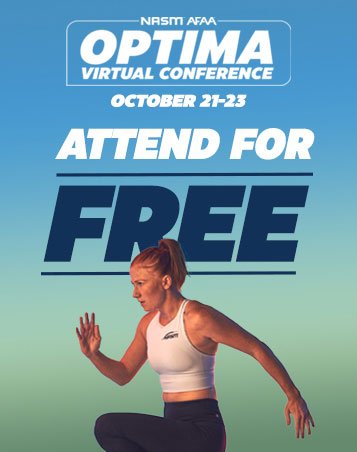在这三部分系列的前两部分中,讨论了测量关节活动范围(ROM)的好处以及使用智能手机应用程序测量下肢活动范围和腰盆-髋关节复合体(LPHC)的技术。
本系列的第三部分也是最后一部分将介绍用于测量肩部(即屈曲、伸展、内旋和外旋)、肘部(即肘部屈曲)和腕部(即屈曲和伸展)关节上肢ROM的技术。
就像提醒一样,测量ROM在NASM更新中提供的移动性测试纠正运动专业化(CES)认证课程和认证教科书资源第10章矫正运动培训的必要性(第2 ED)bob官方app可以确认健身专业人员的静态和动态姿势评估结果,并帮助确定可能的肌肉失衡(即过度活动/缩短和活动不足/延长的肌肉)。
使用智能手机应用程序测量上肢运动范围
注:在测试客户之前,请提供说明并演示每个测试。
仰卧无源肩胛骨屈曲
ROM测量说明:将客户端躺在桌子上或钩子位置的地板上(即,臀部弯曲至大约45度,膝盖弯曲至大约90度,脚平坦)。通过他们的手掌彼此面对,通过放松并允许重力将双臂拉向桌子或地板,让客户在头部上方同时弯曲他们的肩膀。
客户的腰椎应在桌子或地板上保持平坦,并没有进入延伸。此外,客户的肘部应该能够进入几乎完整的延伸,而障碍不应该提升(国家体育学院,2022年)。在水平位置设置智能手机应用到0度,并将智能手机放置在右上臂后表面的中间三分之一上的右上角的肌肉(Werner等,2014)(图1)。

图1.仰卧无源肩部屈曲
请注意,更新版本的阈值+泡沫级智能手机应用程序可能需要额外费用,其读取超过90度(即,90至360度)。测量到最近的程度或十分之一,并在对面的肩部上重复。
普通rom.:150-180度(美国医学协会,1988; Greene&Heckman,1994)
ROM受限时肌肉过度活动/缩短/s:Latissimus Dorsi,Teres Major,Pectoralis Major(下纤维)
仰卧无源肩部延伸
ROM测量说明:让客户在挂钩位置的桌子上仰卧仰卧,并定位在桌子的右侧侧面。While keeping the elbow in extension, the wrist in a neutral position, and the palm facing upward (i.e., the radioulnar joint in supination), have the client allow gravity to pull their shoulder into extension, bringing the arm and hand down towards the floor while keeping the palm facing upward.
患者肘部应保持伸展状态,肩胛骨不应抬高、向前倾斜或延长,手腕不应伸展(美国国家运动医学院,2022年)。当处于水平位置时,将智能手机应用程序设置为0度,并将智能手机放置在肱二头肌右上臂前表面的中间三分之一处(Werner等人,2014年)(图2)。测量到最接近的角度或十分之一度,然后在对面的肩膀上重复。

图2.仰卧无源肩部延伸
普通rom.:50-60度(美国医学协会,1988; Greene&Heckman,1994);45度(国家体育学院,2022年)
ROM受限时肌肉过度活动/缩短/s:前三角肌、胸大肌(上部纤维)、喙臂肌、肱二头肌
仰卧无源肩部内部旋转
ROM测量说明:让客户在桌子上仰卧仰卧,在钩状位置的桌子上,右肩被绑架到90度,右肘弯曲到90度。While keeping the elbow in 90 degrees of flexion, the wrist in a neutral position, and the palm facing forward (i.e., the radioulnar joint in pronation), stabilize the client’s right scapula to prevent anterior tilting or anterior translation of the humeral head by placing your right palm on the client’s anterior shoulder and applying an appropriate amount of pressure downward.
在稳定患者肩胛骨的同时,用左手握住患者的右前臂,同时允许重力将患者的前臂拉向桌子或地板,引导患者的右肩向前内旋(图3)。

图3.肩胛骨和前肩的稳定准备测量仰卧无源肩部旋转
运动的结束范围是肩部停止内部旋转时。健身专业人员在用左手引导患者右肩向内旋转,并用右手稳定患者肩胛骨的同时,感到ROM受限。请客户将肩部和手臂保持在该内部旋转位置进行测试。
客户的肘部应保持在90度屈曲,而肩胛骨不应提升,倾斜,或者拖延,手腕不应弹性(国家体育学院,2022年)。将智能手机应用程序设置为0度,而在垂直位置,将智能手机放在右前臂上表面的中间三分之一(Werner等,2014)(图4)。测量到最近的程度或十分之一,并在对面的肩部上重复。

图4.仰卧无源肩部内部旋转
普通rom.:45度(Greene&Heckman,1994)
ROM受限时肌肉过度活动/缩短/s:Teres Minor和Infaspinatus
仰卧无源肩部外旋
ROM测量说明:让客户在桌子上仰卧仰卧,在钩状位置的桌子上,右肩被绑架到90度,右肘弯曲到90度。While keeping the elbow in 90 degrees of flexion, the wrist in a neutral position, and the palm facing forward (i.e., the radioulnar joint in pronation), have the client allow gravity to pull their shoulder posteriorly into external rotation, bringing their forearm towards the table or floor. The client’s elbow should remain in 90 degrees of flexion, while the scapula should not elevate, and the wrist should not extend (National Academy of Sports Medicine, 2022). Set the smartphone application to 0 degrees while in the vertical position and place the smartphone at the middle third of the superior surface of the right forearm (Werner et al. 2014) (Figure 5). Measure to the nearest degree or tenth of a degree and repeat on the opposite shoulder.

图5.仰卧无源肩部外旋
普通rom.:90度(美国医学协会,1988; Greene&Heckman,1994)
ROM受限时肌肉过度活动/缩短/s:子海面图,Teres Major,Latissimus Dorsi和Pectoralis Major
积极的肘部屈曲
ROM测量说明:当患者处于站立或坐姿,右臂伸直在患者一侧,肘部完全伸展,手掌朝前(即旋后的尺桡关节)时,让患者在不弯曲手腕的情况下尽可能地弯曲肘部。当处于垂直位置时,将智能手机应用程序设置为0度,并将智能手机放置在右前臂前表面的中间三分之一处(Behnoush等人,2016;孔等人,2020年)(图6)。

图6.主动肘关节屈曲
请注意,更新版本的阈值+泡沫级智能手机应用程序可能需要额外费用,其读取超过90度(即,90至360度)。测量到最近的程度或十分之一,并在相反的弯头上重复。
普通rom.:140-150度(美国医学会,1988年;格林和赫克曼,1994年)
ROM受限时肌肉过度活动/缩短/s:Triceps Brachii.
活跃的手腕屈曲
ROM测量说明:当患者处于站立或坐姿,右上臂伸直在患者一侧,肘部弯曲90度,手掌朝上(即旋后桡尺关节)时,患者尽可能弯曲手腕,而不弯曲肘部。当处于水平位置时,将智能手机应用程序设置为0度,并将智能手机放在右手的背面,手指保持笔直(Mistude等人,2019年)(图7)。测量到最接近的度或十分之一度,然后在另一只手腕上重复。

图7.主动腕关节屈曲
普通rom.:60-80度(美国医学会,1988年;格林和赫克曼,1994年)
ROM受限时肌肉过度活动/缩短/s:手腕伸肌
积极的手腕延伸
ROM测量说明: While in a standing or seated position and the right upper arm straight at the client’s side, their elbow in 90 degrees of flexion, and their palm facing upward (i.e., the radioulnar joint in supination), have the client extend their wrist as far as possible without extending their elbow. Set the smartphone application to 0 degrees while in the horizontal position and place the smartphone on the palmar surface of the right hand with the fingers remaining straight (Modest et al., 2019) (Figure 8). Measure to the nearest degree or tenth of a degree and repeat on the opposite wrist.

图8.主动腕关节伸展
普通rom.:60-80度(美国医学会,1988年;格林和赫克曼,1994年)
ROM受限时肌肉过度活动/缩短/s:手腕屈肌
测量运动范围和健身专业人士:外卖
在过去十年左右,越来越多的健身专业人士意识到与客户进行彻底的健康和健身评估的好处。现在,这些健康和健身评估通常包括静态和动态的姿势评估和移动性评估,以帮助检测受限制的关节rom和可能的肌肉不平衡(即,过度活跃/缩短或不足/加长的肌肉),这可能导致性能和损伤减少。
但是,尽管移动性评估,如NASM更新的纠正运动专业化(CES)认证课程和认证教科书资源第10章矫正运动培训的必要性(第2 ED)bob官方app, can assist in detecting limited joint ROM, simply assessing ROM through visual observation does not provide the fitness professional with objective data (i.e., degrees of ROM) which can be valuable information not only during the initial health and fitness assessment but more importantly during follow-up assessments to show progressive improvements in ROM within joints that may demonstrate limited mobility.
因此,这三部分系列的目的是指导健身专业人员如何利用智能手机应用来测量联合ROM来收集客观数据,然后向客户展示精心设计,个性化纠正的有形益处练习计划。
图中的学生:Darcel Tinner(健康与人类绩效专业)
学生摄影师:Joshua Danson(运动科学专业)
数字中的ROM测试仪:Ryan R. Fairall博士
参考:
- 美国医学协会(1988年)。永久性损伤评估指南(第3版)。美国医学协会。
- Behnoush,B.,Tavakoli,N.,Bazmi,E.,Fard,F. N.,Shahi,M.H.P.P.,Okazi,A.,&Mokhtari,T.(2016)。智能手机和普通测测测量肘关节动作的测量仪:比较研究。亚洲运动医学杂志,7(2),1-6。https://doi.org/10.5812/ASJSM.30668
- Greene,W. B.,&Heckman,J. D.(1994)。关节运动的临床测量。美国骨科外科医生。
- Koong,D.P.,Lee,J.,Cheng,T.L.,&Little,D. G.(2020)。智能手机倾斜度计的有效性和可靠性,用于测量小儿患者肘关节弯头运动范围的应用。儿童骨科,14(5),488-494。https://doi.org/10.1302/1863-2548.14.200123
- 谦虚,J.,克莱尔,B.,德马西,R.,梅勒内尔,S.,霍利,A.,奥宾,M.,琼斯,M(2019). 使用内置iPhone功能与通用测角仪进行对比,由手腕受伤和手腕健康的研究参与者自行测量手腕的运动范围。手部治疗杂志,32(4),507-514。https://doi.org/10.1016/j.jht.2018.03.004
- 国家运动医学院(2022年)。NASM矫正训练要点(第二版)。琼斯和巴特利特学习。bob官方app
- Werner,B. C.,Holzgrefe,R.E.,Griffin,J.W.,Lyons,M.L.,Cosgrove,C.T.,Hart,J. M.,&Brockmeier,S. F.(2014)。验证智能手机锚床应用肩部运动范围测量创新方法。肩部和肘部手术杂志,23(11),275-282。https://doi.org/10.1016/j.jse.2014.02.030

















